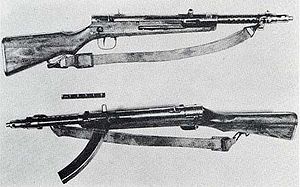
Back رشاش طراز 100 Arabic Type 100 (pistolenn-vindrailher) Breton Samopal typu 100 Czech Typ 100 Maschinenpistole German Subfusil Tipo 100 Spanish Tüüp 100 (püstolkuulipilduja) Estonian Type 100 Finnish Pistolet-mitrailleur Type 100 French Type 100 Italian 一〇〇式機関短銃 Japanese
| Type 100 submachine gun | |
|---|---|
 Late model Type 100 | |
| Type | Submachine gun |
| Place of origin | Empire of Japan |
| Service history | |
| In service | 1942–1954[1] |
| Used by | Imperial Japanese Army Imperial Japanese Navy |
| Wars | World War II |
| Production history | |
| Designer | Kijiro Nambu |
| Designed | 1939 |
| Manufacturer | Nagoya Arsenal[2] |
| Produced | 1942–1945[1] |
| No. built | ~8,500–10,000[a] |
| Variants | Type 100/40 (with solid stock) Type 100/40 (with folding stock) Type 100/44 (with solid stock) |
| Specifications | |
| Mass | 3.7 kg (8 lb 3 oz) (1942, empty)[3] 4.2 kg (9 lb 4 oz) (1942, loaded) 3.8 kg (8 lb 6 oz) (1944, empty)[3] 4.4 kg (9 lb 11 oz) (1944, loaded)[1] |
| Length | 890 mm (35 in) (1942)[3] 900 mm (35.4 in) (1944)[1] |
| Barrel length | 228 mm (9 in) (1942) 230 mm (9 in) (1944)[1] |
| Cartridge | 8×22mm Nambu |
| Caliber | 8mm |
| Action | Blowback |
| Rate of fire | 450 rounds per minute (1942)[1] 800 rounds per minute (1944)[1] |
| Muzzle velocity | 335 m/s (1,099 ft/s)[1] |
| Effective firing range | 100–150 m (110–160 yd)[4] |
| Feed system | 30-round detachable curved box magazine[1] |
The Type 100 submachine gun (一〇〇式機関短銃, Hyaku-shiki kikan-tanjū) was a Japanese submachine gun used during World War II and the only submachine gun produced by Japan in any quantity. It was made in two basic variants referred to by American and British observers as the Type 100/40 and the Type 100/44, the latter also known as the Type 100 (simplified).[3] A small number of the earlier version were converted into using folding stock, sometimes referred to by the Allies as the Type 100 navy, which was made for parachutists.[3]
- ^ a b c d e f g h i Bishop, Chris (2002). The Encyclopedia of Weapons of WWII: The Comprehensive Guide to Over 1,500 Weapons Systems, Including Tanks, Small Arms, Warplanes, Artillery, Ships, and Submarines. Sterling. p. 254. ISBN 1-58663-762-2.
- ^ Type 100 submachine gun production number (1945)
- ^ a b c d e Miller, David (2007). Fighting Men of World War II: Uniforms, Equipment and Weapons. Vol. 1. Stackpole Books. p. 279. ISBN 978-0-8117-0277-5.
- ^ WORLD WAR GUN STATS by Gary Astleford
Cite error: There are <ref group=lower-alpha> tags or {{efn}} templates on this page, but the references will not show without a {{reflist|group=lower-alpha}} template or {{notelist}} template (see the help page).